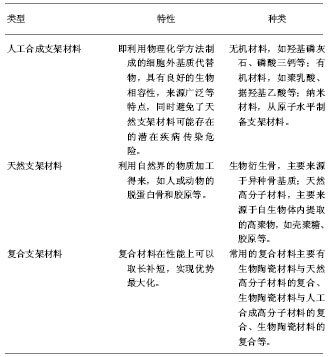| [1] Cancedda R, Giannoni P, Mastrogiacomo M. A tissue engineering approach to bone repair in large animal models and in clinical practice.Biomaterials. 2007;28(29): 4240-4250.
[2] Reddi AH. Morphogenesis and tissue engineering of bone and carti-lage: inductive signals, stem cells, and biomaterials. Tissue Eng.2000;6(4): 351-359.
[3] Kassem M.Stem cells: potential therapy for age-related diseases.Ann N Y Acad Sci.2006;1067:436-442.
[4] 袁捷,祝联,王敏,等. 自体骨髓基质干细胞-珊瑚羟基磷灰石修复下颌骨节段缺损的实验研究[J].中华口腔医学杂志,2006,41(2): 94-97.
[5] Banfi A,Muraglia A,Dozin B,et al.Proliferation kinetics and differentiation potential of ex vivo expanded human bone marrow stromal cells: Implications for their use in cell therapy. Exp Hematol.2001;28(6):707-715.
[6] Kern S,Eichler H,Stoeve J,et al.Comparative analysis of mesenchymal stem cells from bone marrow, umbilical cord blood, or adipose tissue.Stem Cells. 2006;24(5): 1294-1301.
[7] 鞠秀丽,黄志伟,时庆,等. 体外扩增脐血间充质干细胞的生物学特性和诱导分化能力的研究[J].中华儿科杂志,2005,43(7): 499-502.
[8] Zuk PA,Zhu M,Mizuno H,et al. Multilineage cells from human adipose tissue: implications for cell-based therapies.Tissue Eng.2001;7(2):211.
[9] Friedlaender GE,Perry CR,Cole JD,et al.Osteogenic protein-1 (bone morphogenetic protein-7) in the treatment of tibial nonunions.J Bone Joint Surg Am.2001;83-A Suppl 1(Pt 2): S151-S158.
[10] Lee SJ,Park YJ,Park SN,et al. Molded porous poly (L- lactide) membranes for guided bone regeneration with enhanced effects by controlled growth factor release.J Bined Mater Res. 2001;55(3):295-303.
[11] Lacroix D,Chateau A,Ginebra MP,et al.Microrfinite elementmodel of bone tissue engineeting scaffolds. Biomaterials. 2006;27(30):5326-5334.
[12] Morishita T,Honoki K,Ohgushi H,et al. Tissue engineering approach to the treatment of bone tumors: three cases of cells.Artif Organs.2006;30(2):115-118.
[13] Meyer U,Buchter A,Hohoff A,et al.Image-based extracorporeal tissue engineering of individualized bone constructs.Int J Oral Maxillofac Implants.2005;20(6): 882-890.
[14] 姚晖,杜昶,杨韶华,等.纳米羟晶/胶原仿生骨修复家兔颅颌骨缺损的实验研究[J].透析与人工器官,2000,11(2):5-8.
[15] 丁珊,李立华,周长忍.PLA/液晶复合膜的制备及其性能研究[J].生物医学工程学杂志,2002,19(3):383-385.
[16] Chen RN,Wang GM,Chen CH,et al.Development of N, O-(carboxymethyl)chitosan/collagen matrixes as a wound dressing.Biomacromolecules.2006;7(4):1058-1064.
[17] Wittaya AS,Prahsarn C.Development and in vitro evaluation of chitosan-polysaccharides composite wound dressings.Int J Pharm.2006;313(1-2):123-128.
[18] 章文苑,旅娅婧.纳米羟基磷灰石/Ⅰ型胶原/壳聚糖复合支架材料的制备与优化[J].生物骨科材料与临床研究,2011,8(3):1-4.
[19] Cruz DM,Gomes M,Reis RL,et al. Differentiation of mesenchymal stem cells in chitosan scaffold with double micro and macroporosity.J Biomed Mater Res.2010;95A(4): 1182-1193.
[20] Chen G,Sato T,Ushida T,et al.Tissue engineering of cartilage using a hybrid scaffold of synthetic polymer and collagen. Tissue Eng.2004;10(3-4):323-330.
[21] 杨志明,樊征夫.组织工程化人工骨血管化研究[J].中华显微外科杂志,2002, 25(2): 119-122.
[22] 徐红珍,苏俭生.组织工程骨的血管化研究进展[J].中华临床医师杂志,2010,4(4):456-458.
[23] Unger RE,Sartoris A,Peters K,et al.Tissue-like self-assembly in cocultures of endothelial cells and osteoblasts and the formation of microcapillary-like structures on three-dimensional porous biomaterials. Biomaterials.2007; 28(27):3965-3976.
[24] Kaigler D,Krebsbach PH,Polverini PJ,et al.Transplanted endothelial cells enhance orthotopic bone regeneration.J Dent Res.2006;85(7):633-637.
[25] Usami K,Mizuno H,Okada K,et al.Composite implantation of mesenchymal stem cells with endothelial progenitor cells enhances tissue- engineered bone formation.J Biomed Mater Res A.2009;90(3):730-741.
[26] Liu L,Ratner BD,Sage EH,et al.Endothelial cell migration on surface-density gradients of fibronectin, VEGF, or both proteins.Langmuir. 2007;23(22):11168-11173.
[27] 金丹,陈滨,裴国献,等. 筋膜瓣促组织工程骨再血管化及山羊长段骨缺损的修复[J].中华实验外科杂志,2005,22(3): 269-271.
[28] Blidisel A,Mǎciuceanu B,Jiga L,et al.Endoscopy-assisted harvesting and free latissimus dorsi muscle flap transfer in reconstructive microsurgery.Chirurgia (Bucur).2008;103(1): 67-72.
[29] Zhao M,Zhou J,Li X,et al.Repair of bone defect with vascularized tissue engineered bone graft seeded with mesenchymal stem cells in rabbits.Microsurgery.2011;31(2) : 130-137.
[30] Wang XT,Liu PY,Tang JB. PDGF gene therapy enhances expression of VEGF nad bFGF genes and activates the NF- kB gene in signal pathways in ischemic flaps. Plast Reconstr Surg.2006;117(1):129-137.
[31] 何清义,李强,温立升,等.组织工程骨血管化的研究进展[J].中国矫形外科杂志, 2005,13(19):1499-1501.
[32] Kale S,Biermann S,Edwards C,et al.Three-dimensional cellular development is essential for ex vivo formation of human bone.Nat Biotechnol.2000; 18(9):954-958.
[33] 翦新春,成洪泉,许春姣.天然生物衍生支架材料在骨组织工程中的应用进展[J]. 口腔颌面外科杂志,2003,13(3):239-242.
[34] Murphy CM,Haugh MG,O’Brien FJ.The effect of mean pore size on cell attachment, proliferation and migration in collagen-glycosaminoglycan scaffolds for bone tissue engineering. Biomaterials.2010;31(3):461-466.
[35] Kim K,Dean D,Mikos AG,et al.Effect of initial cell seeding density on early osteogenic signal expression of rat bone marrow stromal cells cultured on cross-linked poly(propylene fumarate) disks. Biomacromolecules.2009;10(7):1810-1817.
[36] Karageorgiou V,Kaplan D.Porosity of 3D biomaterial scaffolds and osteogenesis. Biomaterials.2005;26(27): 5474-5491.
[37] Byrne EM,Farrell E,McMahon LA,et al.Gene expression by marrow stromal cells in a porous collagen-glycosaminoglycan scaffold is affected by pore size and mechanical stimulation.J Mater Sci Mater Med.2008;19(11):3455-3463.
[38] Kasten P,Beyen I,Niemeyer P,et al.Porosity and pore size of betatricalcium phosphate scaffold can influence protein production and osteogenic differentiation of human mesenchymal stem cells: an in vitro and in vivo study. Acta Biomater.2008;4(6):1904-1915.
[39] Sundelacruz S,Kaplan DL.Stem cell- and scaffoldbased tissue engineering approaches to osteochondral regenerative medicine.Semin Cell Dev Biol.2009;20(6):646-655.
[40] Betz MW,Yeatts AB,Richbourg W,et al.Macroporous hydrogels upregulate osteogenic signal expression and promote bone regeneration. Biomacromolecules.2010; 11(5): 1160-1168.
[41] Yang SF,Leong KF,Du ZH,et al.The design of scaffolds for use in tissue engineering. Part 1. Traditional factors.Tissue Eng. 2001;7(6):679-689.
[42] Uebersax L,Hagenmuller H,Hofmann S,et al.Effect of scaffold design on bone morphology in vitro. Tissue Eng.2006; 12(12): 3417-3429.
[43] Rose FR,Cyster LA,Grant DM,et al.In vitro assessment of cell penetration into porous hydroxyapatite scaffolds with a central aligned channel. Biomaterials.2004;25(24):5507-5514.
[44] Shor L,Guceri S,Wen X,et al.Fabrication of three-dimensional polycaprolactone/hydroxyapatite tissue scaffolds and osteoblast-scaffold interactions in vitro. Biomaterials.2007; 28(35):5291-5297. |
